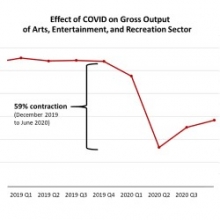Friday, April 30, 2021
Building on two previous letters of support (May 2020, August 2020) for relief and recovery efforts to help the arts, culture, and the creative sector, a coalition of 113 chambers of commerce in 46 states delivered a letter to U.S. House and Senate leadership on April 26, 2021 asking that $18 billion be allocated within the forthcoming infrastructure recovery bills specifically to support creative economic recovery. Signatories come from chambers in communities of all sizes and geographies, including Los Angeles; Seattle; Miami; Bentonville, Arkansas; Detroit; Providence, Rhode Island; St. Louis; Pittsburgh; Mobile, Alabama; Las Vegas; and Houston. The businesses represented by these chambers collectively serve over 33 million Americans.
Spearheaded by the Greater Boston Chamber of Commerce, the Association of Chamber of Commerce Executives, and Americans for the Arts, the letter argues that dedicated recovery funds for the creative economy are essential to getting local small businesses and economies back on their feet.
The creative economy is an economic engine that generated $919.7 billion in economic activity in 2019, according to the Bureau of Economic Analysis (BEA)—a larger percentage of the GDP than transportation, tourism, or construction and a crucial component of every state’s economic health.[1] The arts are a jobs multiplier, creating jobs at twice the national rate, and according to research from Indiana University, arts are economic catalysts that accelerate economic recovery, and a growth in arts employment has a positive and causal effect on overall state employment.[2]
While the 2020 CARES Act and the American Rescue Plan Act of 2021 provided much-needed relief to many businesses, there are critical gaps in the aid that fail to meet the needs of the creative and cultural economy. A report from the Brookings Institution[3] found that the country’s 670,000 creative economy businesses had collectively lost at least $150 billion by August 2020 (and have continued to lose revenue at the same rate). At the height of the pandemic, 63% of all creative workers were unemployed, and the sector unemployment rate continues to be 5-6 times the national average.[4]
Johns Hopkins University and the international Organisation for Economic Co-operation and Development warn[5] that the creative sector is among the most impacted industries in the country—with damaging ripple effects to restaurants, tourism, travel, and local businesses. The creative sector contracted by 59% between the end of 2019 and mid-2020—twice the rate of other highly impacted industries[6]—and, according to the Small Business Survey from the U.S. Census Bureau, is rebounding at a slower rate and will not reach pre-pandemic levels until sometime in 2022.[7]

The signatory chambers on this letter recognize that there can be no full recovery without the creative economy and are calling for Congress to support dedicated recovery funding because they know that creative product drives tourism, travel, hospitality, local small business, and social and economic health. That’s why they support the integration of the following core funding and policy recommendations into the forthcoming American Jobs Plan, which echo the Put Creative Workers to Work policy platform endorsed by over 2,300 creative businesses and creative workers in all 50 states:[8]
- Allocate $14 billion to incentivize local, state, and tribal businesses and governments to put creative workers to work addressing social, cultural, and physical infrastructure needs.
- Allocate $3 billion to spark an American cultural renaissance through creative jobs, fellowships, residencies, and commissions.
- Allocate $1 billion in arts and creativity-based education for recovery to incentivize retention of arts educators and improve the education infrastructure.
- Direct the Federal Reserve to broaden their nonprofit lending facility under the Main Street Lending Program to specifically benefit mid-size nonprofits.
To read the full letter, click here.
Chambers interested in adding their signature to the letter may still do so by following this link.
In addition to Congressional leaders, the letter has been shared with the House and Senate representatives for all signatories and senior leaders in the White House. Those interested in supporting efforts to dedicate funds to creative economic recovery can visit www.CreativeWorkers.net to send a letter to their Congressional representatives, share resources on social media, join the growing coalition of partners, and access other resources.
[1] Source: U.S. Bureau of Economic Analysis, 2020
[2] Source: Indiana University, 2020
[3] Source: Brookings Institution, 2020
[4] Source: Bureau of Labor Statistics, analysis by Johns Hopkins University, 2021
[5] Source: Johns Hopkins University and Organisation for Economic Co-operation and Development, 2020
[6] Source: U.S. Bureau of Economic Analysis, 2021
[7] Source: Small Business Pulse Survey, administered by the U.S. Census Bureau, 2021






